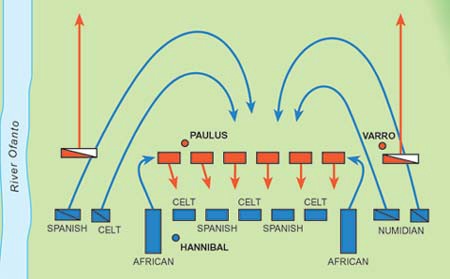Cultural depictions of Hannibal. Hannibal lived during a period of great tension in the western Mediterranean Basin, when the Roman Republic established its supremacy over other great powers such as ancient Carthage, the Etruscans, Samnites and the Greek kingdom of Syracuse. One of his most famous achievements was at the outbreak of the Second Punic War, when he marched an army which included war elephants from Iberia over the Pyrenees and the Alps into Italy. Hannibal became famous when his army almost destroyed the western Roman empire and when he defeated the Roman army with his brilliant war strategy. That battle remained one of the most important battles in history. First, because of the outcome – for the first time the Roman army was defeated, and not just defeated, they were basically destroyed by Hannibal’s army. Therefore the myth of “perfect invincible army” was demystified. That was a crucial point for roman enemies, they finally understood that they too can confront this enemy and that they can defeat the Romans. Eventually that was the fact that encouraged Roman enemies to fight against their repressors and in the end to conquer the Roman Empire. But, the most important thing about Hannibal and his legacy is his war strategy. The Battle of Cannae was a major battle of the Second Punic War that took place on 2 August 216 BC in Apulia, in southeast Italy. The army of Carthage, under Hannibal, surrounded and decisively defeated a larger army of the Roman Republic under the consuls Lucius Aemilius Paullus and Gaius Terentius Varro. It is regarded both as one of the greatest tactical feats in military history and as one of the worst defeats in Roman history. “Hannibal ante portas” in Latin means “Hannibal is at the gates”. Yes , with his famous “horseshow” strategy he humiliated the army of the Roman Republic. The road to Rome has left opened and defenseless. The Romans were so surprised and scared because they believed that the Rome is “a mission impossible” for any enemy , let alone for some barbarian general like Hannibal. The conventional deployment for armies of the time was placement of infantry in the center, with the cavalry in two flanking wings. The Romans followed this convention fairly closely, but chose extra depth rather than breadth for the infantry in hopes of breaking quickly through the center of Hannibal’s line. Varro knew how the Roman infantry had managed to penetrate Hannibal’s center at Trebia, and he planned to recreate this on an even greater scale. Varro believed that when pressed hard by the Romans’ superior numbers, the Carthaginians would fall back to the river and, with no room to maneuver, would be cut down in panic. Hannibal, on the other hand, had deployed his forces based on the particular fighting qualities of each unit, taking into consideration both their strengths and weaknesses. This aspect of Hannibal’s leadership was highlighted in the use of a Spanish unit, the Balearic slingers, whom he placed behind the infantry to hurl their ranged missiles into the masses of Roman troops. He placed his Iberians and Gauls in the middle, alternating the ethnic composition across the front line, with himself at the front and center. The rest is history. When two armies collided in battlefield pushed from the wings instead of frontal combat. That surprised Roman army and Hannibal literally crushed them because he deployed his army otherwise and push hard from the wings, forming his famous “horseshoe”…The Roman Empire would easily fail that day, but they had an enormous amount of luck…But underestimated general Hannibal showed them that day that they are not invincible. From that day the concept of war changed, this was the legacy of Hannibal.





